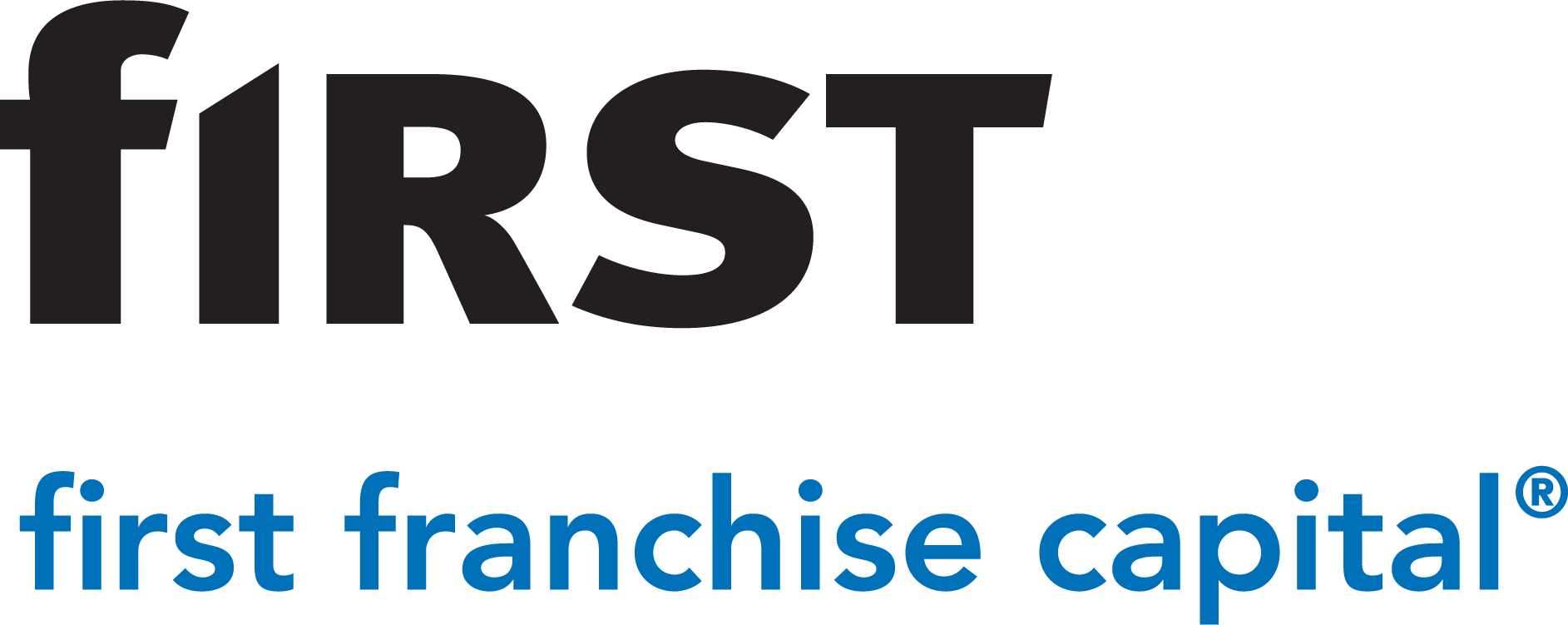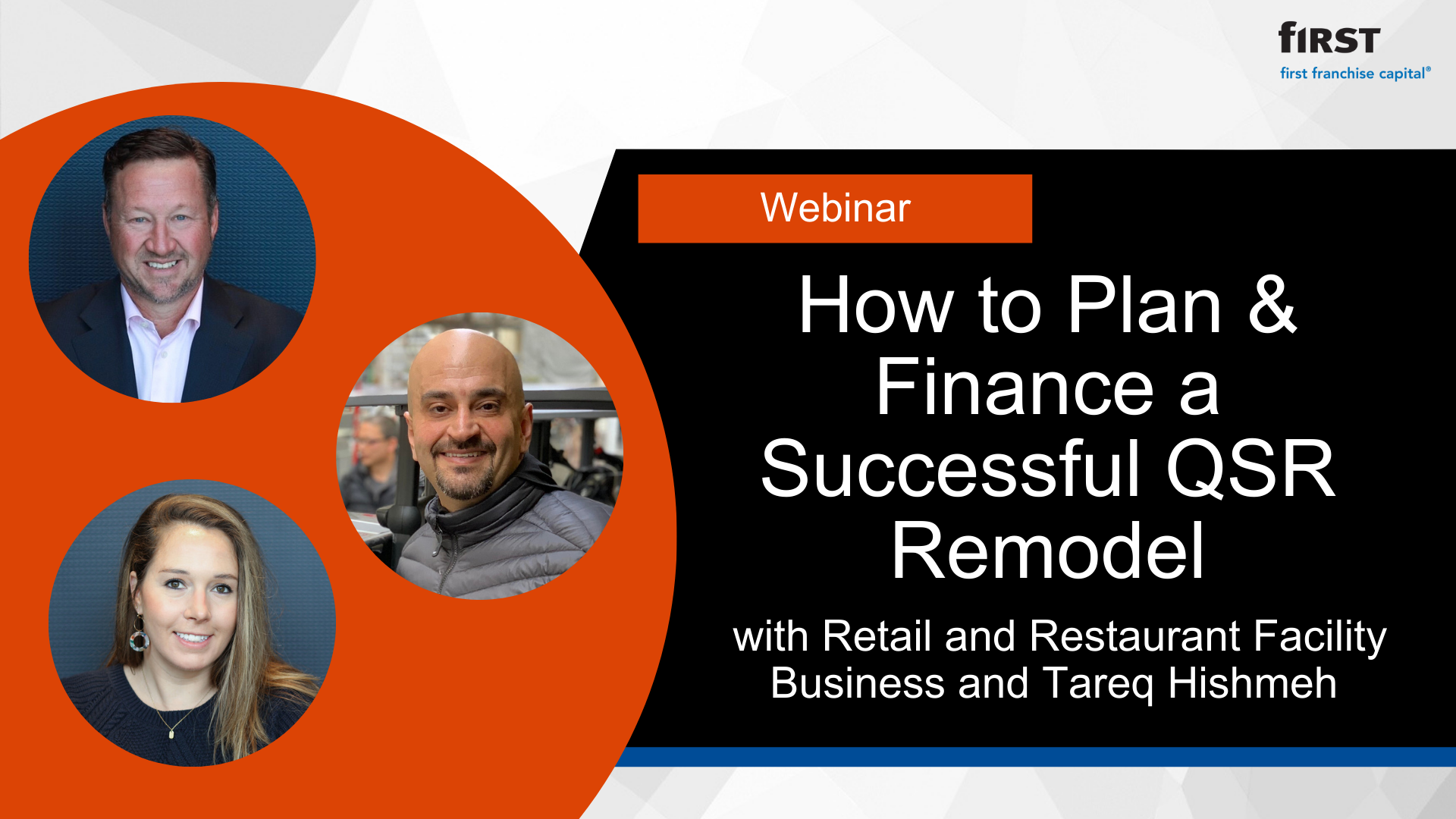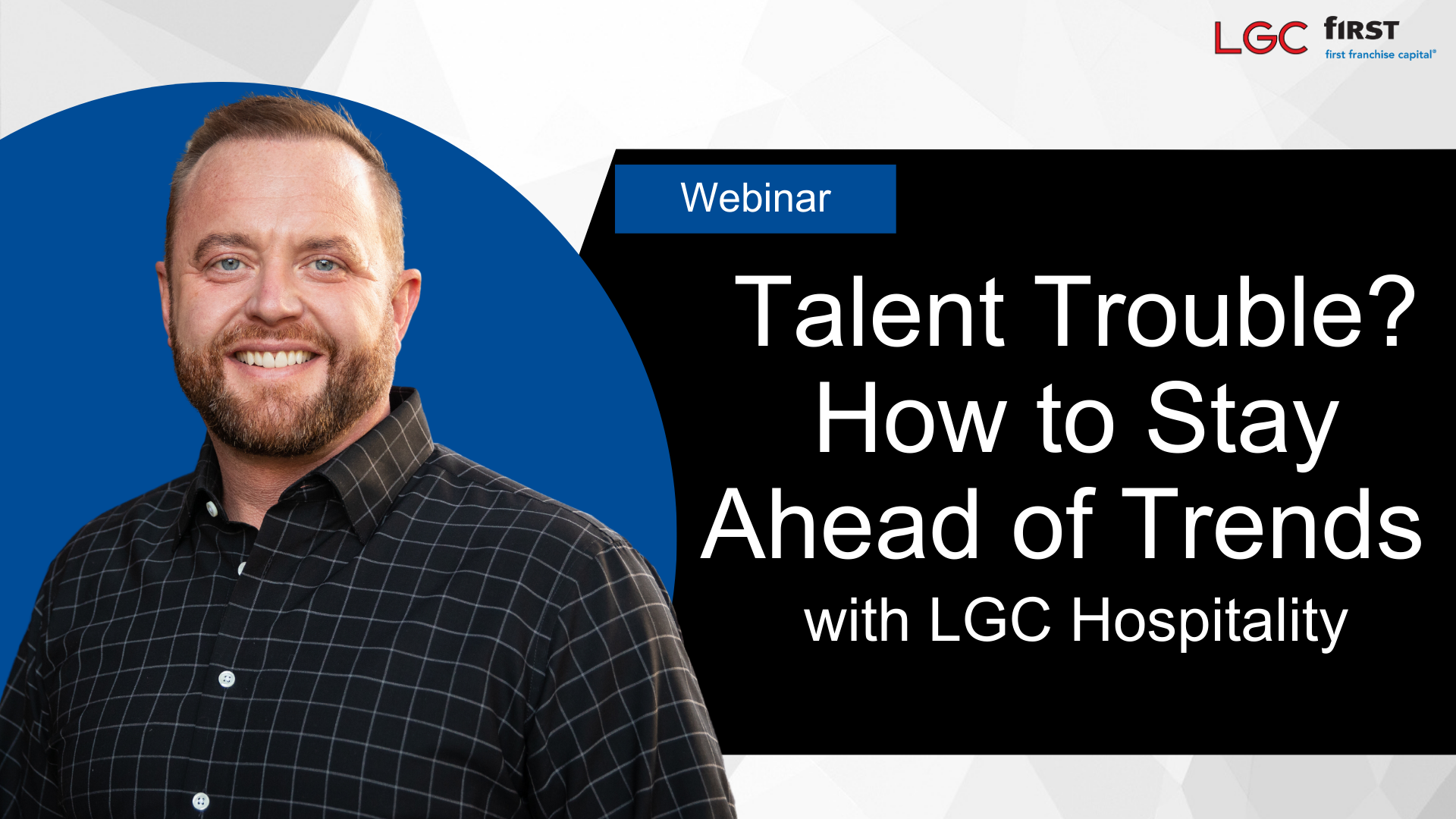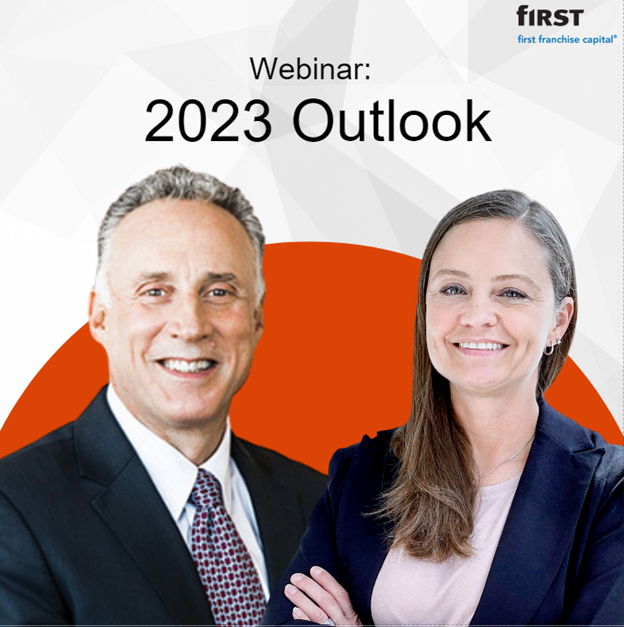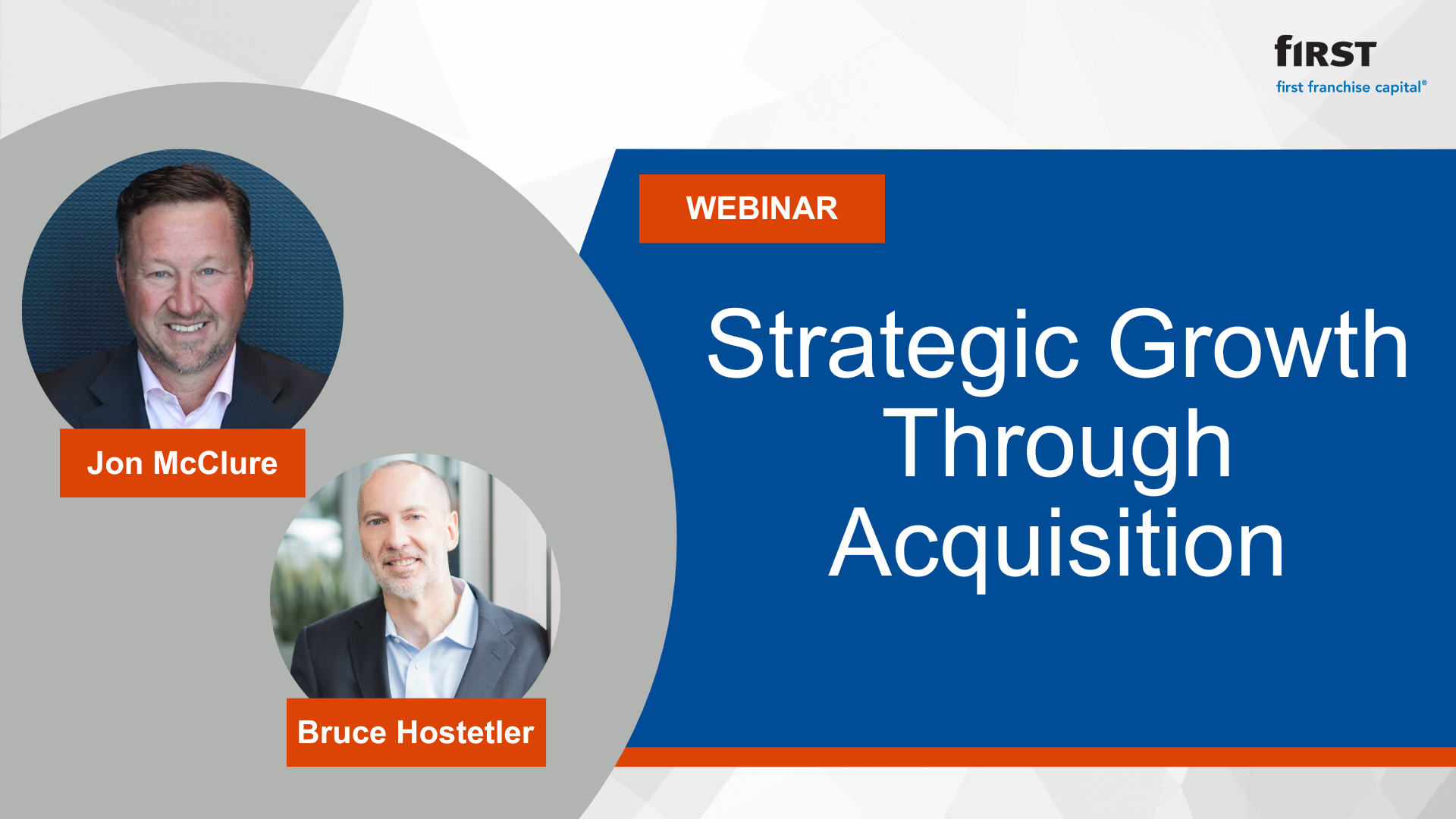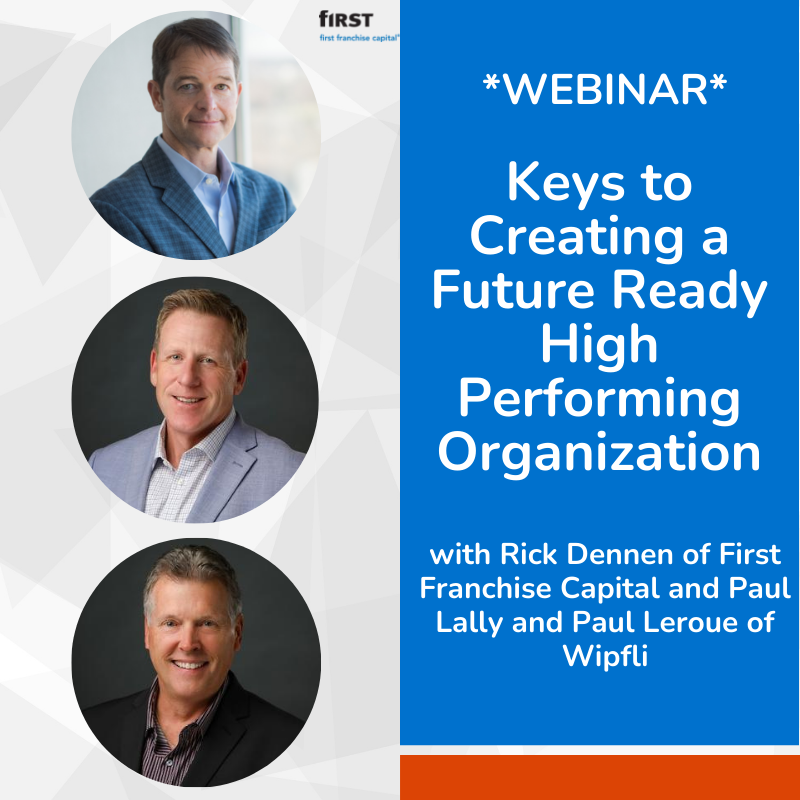How to Plan & Finance a Successful QSR Remodel
- 0.5
- 1
- 1.25
- 1.5
- 1.75
- 2
Randy Sharon: Hello and welcome. I'm Randy Sharon for Retail and Restaurant Facility Business Magazine. Thank you for joining our webinar, How to Plan and Finance a Successful QSR Remodel. Today we'll be discussing how QSR franchisees can plan and execute a successful remodel. Our expert panelists will also cover financing options, industry challenges, and information on how to drive more traffic through remodeling. This webinar is sponsored by First Franchise Capital. With that, I'll hand the discussion over to our expert panelist starting with Tracy Holiday, Vice President of Franchise Lending with First Franchise Capital.
Tracy Holliday: Hello, everyone. Thank you for joining us as we discuss why remodeling can be a great growth strategy for franchisees, how to plan and execute a successful remodel project and what financing options are available. I'm Tracy Holiday, VP of Franchise Lending with First Franchise Capital, and I'm pleased to introduce our panelists for this discussion. John McClure is Director of Lending at First Franchise Capital. Tareq Hishmeh is the President and CEO of Hishmeh Enterprises, which has been a family- owned business for over 35 years. They started out with one Domino's store in California and now have 107 units in California and Arizona. They've grown organically and through acquisition and today are one of the most respected QSR franchisees, not only in Domino's but in all of QSR. This webinar is being recorded. Within the next couple of business days, you'll receive a follow- up email with a link to today's webinar recording and our contact information if you want to continue the conversation. So let's get started. Why is remodeling important? John, we'll start with you.
Jon McClure: Thank you Tracy, and thank you Tareq. Appreciate both of you. We are honored to have the Hishmeh family as clients of ours for going on about eight years now. They are true partners, so thank you Tareq, and to your whole family. Remodeling is very important. There's both tangible and intangible benefits of remodeling. The intangibles are related to crew members, area managers, and the owners. When you have a remodeled restaurant, you have fresh, exciting, not only the physical aspects of a remodel, but the culture absolutely increases the attitudes and the positivity that go along with remodels. From a physical aspect, it is a necessary piece of QSR. You have to stay modern, again, using the word fresh, curb appeal. Consumers have many options to choose from, and with a remodeled restaurant, you are absolutely going to attract someone's eyes as they drive down the street. When they look around to see where they're going to go, they will absolutely look at a remodeled fresh restaurant versus an old dilapidated restaurant.
Tracy Holliday: Excellent points, John. Tareq?
Tareq Hishmeh: John addressed a couple of them, but what I'd like to add is really the coming up to the times, and if you think about the changes that we've had in technology, in operational efficiencies in the last decade, and generally, remodels are done about once every 10 years or so, in the last 10 years, the world of automation has come in, the world of operational efficiency, brand image enhancement. The world has changed. Think about 10 years ago where delivery was a small part for most businesses. For us, it's always been a big deal, and the answer has been racks and inaudible like that since then. Now, as brands are re- imaging, coming to the times and building the restaurant that addresses today's need and somewhat anticipates the needs of the futures, as well. I think all that in major importance of why remodeling is important.
Tracy Holliday: Yeah, very well said, Tareq. And for many brands, remodeling is often required by franchisors. It is important to meet those requirements and deadlines set by the franchisors. So how should franchisees go about planning and executing a successful remodel project?
Tareq Hishmeh: So to me, there's a couple of pieces that have to come together and one is understanding where your brand is, as far as your remodel obligation. Is it once every 10 years? Is it once? What is the scope? What is the potential budget? Does your franchise agreement give a cap on the amount of money that you have to spend on a remodel? One, understanding your relationship with the bank would be another one. Is your bank going to require you to contribute a portion of that fund or do you have old financing arrangement for those? But that comprehensive planning of where you're working through with all the stakeholders, from the franchisors to the lenders, to your landlords, understanding where your leases are so that potentially you're not spending a lot of money without having a long- term lease to just justify that investment. And then honestly, the last one I would say is having a list of qualified contractors in your area so that you've got the ability to execute in a timely fashion.
Tracy Holliday: Very well said, Tareq. You answered my next question with that as well, some of the best practices that you would share. So how about what are some of the challenges associated with remodels that you wish that you would've known when you did your first remodel?
Tareq Hishmeh: Oh boy, that's always fun. And part of the biggest challenges with remodeling is anticipating what you can't anticipate. And really, the unpredictable nature of the moment that you take a hammer, or a demolition crew enters your restaurant. What is your plan? Are you planning on continuing to stay open? Some of these remodels can take weeks, and obviously, both from a cashflow perspective, but also from a consumer management perspective, shutting down is not an option for a lot of us. So trying to understand what it's going to be like, realizing that if you tell a contractor that we open at 9: 00 AM, they're not going to be done that day until 9: 30 AM, and so you really want to kind of create those buffers and understanding what happens. And honestly having an open communication and understanding of what your health department is going to require. Are they going to be okay with you staying open? I'll never forget on one of our early remodels, we do a decent size of school lunch business and we had to get a pretty big order in, and the whole plan was, " Hey, everybody knew that we're going to be open." Nobody told the contractor that, " We're going to be coming in at 7: 00 AM that day." And we walk in, and imagine trying to balance. Luckily, we had a store nearby and we shifted and moved stuff around to get it done. But the open communication, understanding what's happening, and all the key stakeholders, again, from the operating side of the business to the construction side of the business getting aligned together, I think that would probably align with the biggest challenges.
Tracy Holliday: Yeah, absolutely, absolutely. Hindsight is 20/ 20, as they say.
Tareq Hishmeh: Always.
Tracy Holliday: Yes. So many franchisors allow the franchisees, I believe, to choose if they wish to remodel, refresh, or re- image their locations. John, can you walk us through what those options look like?
Jon McClure: I can. Every brand is different. Domino's is different, from Taco Bell to Wendy's. And each scope is very, very different, not only in dollars, but as in far as what Tareq just mentioned, the disruption of your operations. And so you've got major, minor, and refreshes, and again, every brand calls it something different. And so what you've got to look at is not only the return on your investment, like Tareq says, are you in a long- term lease? Are you going to get the sales bump? Are you protecting your turf? All those things are critical with a remodel. The cost, the interest rates, and oh, by the way, inflationary pressures of commodities, such as steel and lumber. Look what's happened in the last year. I could only imagine trying to plan for a major remodel, not to mention a minor remodel, with having to plan out what those commodities could look like when you're actually delivering. So when you are looking at the two or three different options that the franchisor has suggested, you've got to weigh lots of different pieces when you're looking at that investment, because you are taking out dollars out of your business, one way or the other, to do this. And you've got to really make sure, not only if you're financing it, what you don't want is to amortize that remodel to the point whereby the time it's paid off, you're already having to remodel again with the franchisor. And a lot of folks will stretch that payment out, for obvious reasons, but it's like it's a perpetual type cycle where they can never get ahead. And then, of course it also comes into play when you're looking to retire or sell. And if you've deferred maintenance and if you've deferred a remodel, when it's time to sell, a buyer's going to look at your restaurants and go, " You haven't done any remodeling." And so then you get into all of that piece. But the difference in a major and a minor remodel can be substantial, and one that has to be weighed accordingly with all the factors.
Tareq Hishmeh: John, if I can add, the other thing to consider is sometimes the right answer is actually a relocation of the entire restaurant. If you think about it, especially with franchises, sometimes your original franchise agreement or the location is 10, 20, 30 years old, and it may have been a prime location 20 years ago, but unfortunately, the city has changed. And then also every once in a while after 10 or 20 years of annual increases in a lease, you may be overpaying for your current location, where it's actually cheaper to move and get some tenant improvement dollars or potential other incentives that are out there, to relocate rather than just doing a refresh. So I think that's also a part of the analysis that would be necessary.
Jon McClure: Yeah, absolutely. You have got to weigh whether it's beneficial to relocate, and not to mention when franchisors ask franchisees to split stores and some of your revenues are not where they were 10 years ago, you are exactly right. And with rent escalations clearly evident in all of these locations, it might be best to relocate down the street where the traffic patterns have changed. Well said.
Tracy Holliday: Tareq, you mentioned possibly relocating. What thoughts do you have on the other options available, as far as choosing between the refresh, the full remodel, and that sort of thing?
Tareq Hishmeh: Yeah, so we had this issue in the last major refresh of the brand, which is about six or seven years ago, and we're about due for our next one. But sometimes, you've got to take a look at the business unit you're in, where you are keeping it open, it is a very healthy store, and it's okay, and all you need to do is a refresh where you're just updating the lobby, adding a different color, tile, painting. So sometimes doing the least is the right answer, but then there are other times where the physical body of the building, the dropped ceiling is outdated. It's been painted a couple of times in the last 10 years, and the right answer may be to do at that point in time, more work at the same time you already have contractors there, you already have painters coming, and so actually, doing a bigger remodel, inaudible the bare minimum, sometimes is the right answer, because you're avoiding a secondary disruption six months or a year or two down the line. Might as well do it all at the same time when you've got people there and their overhead is one and the same at that point in time. It actually reduces costs every once in a while to do more than you just have to, the bare minimums.
Tracy Holliday: That definitely makes sense. That makes sense. A big question, of course, is how to pay for remodeling. Tareq, what options are available, and what led you to first franchise capital to help finance your remodels?
Tareq Hishmeh: For us, financing is always an interesting question. Obviously, with 107 locations, we have the ability to self- finance a lot of these, but sometimes that's not the right use of cash, and going out to the right lenders, and we've had a partnership with First Franchise, as John said, seven or eight years now, might even be a little bit longer. And having a partnership with a bank to where they understand your business, understand your needs, goes a long way. And in our world, we've done a mixed, where a few of them, we'll finance those, and others, we'll step up and have the bank finance 100% of those. And it all adds up at the end of the day, because having that kind of relationship, where you also have a development or a line of credit with the bank for these kind of things, negotiated ahead of time, anticipating the need, but rarely if ever, in my experience, does the brand not lay the seeds for months, if not a year or more, ahead of a refresh mandate where they start talking about it and start previewing stuff. Read the tea leaves, don't put your head in the sand. Simply ignoring it is not going to make it go away, and planning, and having that relationship with a bank goes a long way.
Tracy Holliday: Yeah, definitely.
Jon McClure: And I might add here, awesome Tareq, the communication between us and the Hishmeh family is ongoing. I speak to Tareq several times a month. We see each other a lot, and we visit about each and every project generally, and lots of times my piece will be, " Tareq, just go ahead and just pay cash for this. It's not worth all the pieces involved in financing." So I'll actually encourage them as he's bouncing ideas off me to just say, " Hey, this probably makes more sense to do it this way versus that way. And oh, maybe this time we'll do it this way." So it's an ongoing dialogue throughout the year.
Tracy Holliday: Yeah. John, along that same note, can you walk us through the process franchisees can expect when working with First Franchise Capital?
Jon McClure: I can. Pretty standard type process with banking. We are an actual bank. We're part of First Financial Bank out of Cincinnati, Ohio. We've been around about 160 years. We hold all of our notes, we service all of our notes, and remodeling financing is similar to a loan request for acquisitions, new unit development, shareholder buyouts, and all the other pieces. We do real estate, as well. And so it's gathering financial statements, letting our folks on the front end, the relationship managers, which include myself, and looking at the financials to do the analysis to tee it up for credit, to take a look at and to bless before we issue our term sheets. And from then it moves into credit and underwriting, and to the approval stage, and then to closing. So generally we're closing transactions in about 45 days, but that's it from a high level.
Tracy Holliday: Great. Well said. John, can you walk us through the process franchisees can expect when they're working with First Franchise for financing, and what can a franchisee do to get ready for that?
Jon McClure: Excellent question. Thank you, Tracy. There are a couple pieces to this. You are always having to look towards the future, always looking ahead to see what could, might, be in place for you and your organization a year from now, three years from now, seven years from now, et cetera. But what I would recommend is looking, even though we can finance remodels out to 10 years, that might not always be the best decision. Why? Because obviously, your leverage with your debt and, of course, your fixed charge coverage ratios come into play here and you have to weigh all those pieces. However, if you can structure remodels on a shorter AM to bring your debt down over time, and especially if you're anticipating an acquisition of seven more restaurants two or three years from now, then you'll have that equity in your business to be able to leverage with embedded equity to utilize towards that acquisition and those target units, because what will take place is you'll buy those stores at X, we'll be able to lend you Y, and you're going to need to come up with that delta. And yes, there's a lot of ways to skin that cat, but boy, wouldn't it be nice to have more equity in your business at that time because you've chosen to be prudent with your pay down of our loan. And you can certainly pay extra on your principal with us whenever you want. We certainly allow that. So that's how I would encourage that. As far as the process goes, very standard. We ask for financial statements, we do the analysis, we get with our credit folks to make sure it fits, and then we issue the term sheet for you to take a look at, and we discuss, and then we send into formal underwriting for approval. Process takes about 45 days, but again, we structure and we customize the remodel loans, as well as the other loans, acquisitions, and new unit develop to your need. So that would be my answer.
Tracy Holliday: Well said, John, I know I've seen for myself how important your clients are to you and how we strive to be a true lending partnership and bring long- term value to the people that we get to work with. So this next question is a topic that I think each of us probably speak on every day. Given all the conversations around the continued high inflation, how do you see inflation or potential recession affecting franchise business and their remodel plans?
Tareq Hishmeh: You want me to take that one, John?
Jon McClure: I'll let you go on this one, buddy.
Tareq Hishmeh: All right. I'll tell you, I mean, be prepared for some sticker shock right now. Just because you built something a couple of years ago, heck, even if you built it last month, the world that we're in right now, sticker shock changes are real. And the truth is what may have been expensive last a year ago may now be cheap, and then something that was cheap last year is now blown through the roof. So to me, working with a contractor that understands your needs, has experience in your industry, or even better, if it's within your brand, and then getting them to hold to that budget and putting through. Then, honestly on every budget these days, we're putting at least a 10 to 15% potential for increases, if not more, because right now, budgeting is key. Letting someone start the building and then we'll play it by ear and figure it out as we go along, it's probably a fatal mistake in the world that we're in right. And honestly, the other part, I would say it's a little bit of... Sorry, a value- driven remodeling concept where you're trying to figure out what is necessary, budgeting for that, what is optional, budgeting for that, and then hey, what's a wishlist? Budgeting for that. And if they come in under on certain things, you can go for the optional pieces, but there are times where you've got to look at the value driven model of it in figuring out what absolutely needs done and what will drive the best return, where is the operational efficiency, labor savings, and what's going to increase customer frequency. Playing all that together I think is a key part of the value driven process of remodeling.
Tracy Holliday: John, what would you add?
Jon McClure: Well, well said. Said it all. You've got to plan for contingencies. Rarely do we see remodels come in under budget, so more times than not, we figure it out in the end, whether they're putting in more equity or we're increasing our loan amount to cover that. We do our very best to look at contingencies, and 10 to 15% is probably, that's very good advice. I would certainly count on more, but you really have to look at, like Tareq said, what is necessary in today's environment, given how high the costs are. Do you really need digital menu boards? You might. It depends on the brand, right? It's a nice thing to have, for sure, but boy, does that change the cost. But the technology side of remodels that increase efficiencies is real. Domino's is utilizing it. Obviously, they're one of the kings of technology with their app, everything they've used to drive traffic. And so you really have to look at which pieces of a remodel are going to enhance sales, and in turn enhance EBITDA.
Tracy Holliday: Very well said, both of you. I know restaurant remodeling costs vary based on the scope of work and the specific needs of each restaurant. And along those lines, what does the amortization of a restaurant remodel look like?
Tareq Hishmeh: So, we...
Jon McClure: We... Go ahead.
Tareq Hishmeh: Go ahead, John. Sorry. Go ahead.
Jon McClure: Okay. We'll certainly, like I mentioned before, we'll certainly structure it however you want. We can customize remodels. We will do them for two, three years. We'll do them for 10. It just really depends, again, on the length of the lease, the return on the investment and the scope of the work. And you've got to balance all of those with your cashflow of your business and what your future looks like for you. Are you young like Tareq? Are you older or are you in a different place in your career? Are you looking to retire? It really depends on all those things. And not to mention, you've got to really get with your franchisor because they'll come out with an image and then eight months later, they'll get feedback and they'll figure out, " Oh wait, maybe we need to change this based on what we've seen." And that happens all the time, the scope of work, and I know Tareq can comment on that.
Tareq Hishmeh: Oh, yeah. We've got a saying in our brand, " Sometimes it doesn't pay to be one of the first," to follow up with inaudible. The first pioneers, and the pioneers are risking it all at times, and then with time value, efficiency of the brand, buying more of those counters, or whatever the piece may be, drives price down. Sometimes you don't want to be the first guy in line to raise your hand, but to me, allowing others to make the process more efficient and learning from them goes a long way. And John, you've definitely hit a soft spot there. It's always interesting to see how much the image, even a re- image, can change from the moment it's announced to a couple years later as the rest of the group are coming along.
Jon McClure: Right.
Tracy Holliday: Yeah. Thank you. Very good information. We've received a couple questions from the audience, and some you've addressed already. Another question from our audience is can you talk a little about itineraries and how QSRs might implement a strategy of incremental updates?
Tareq Hishmeh: So to me, an incremental update has got a lot of positives, but potentially some negatives, because with an incremental update, you're anticipating the future needs. And unless you can truly read the future, which if you are, we may be in the wrong industry. To me, you can't predict where the brand is going to be 10 years from now. So if over 10 years, you're making updates and continuing to make that continuous updates to your restaurants, you may find yourself still facing a$ 200,000 remodel, or$ 100,000 remodel, nonetheless. To me, there's a difference between maintenance and upkeep, and an ongoing remodeling. Now, as far as an incremental refresh, we do that obviously all the time. Every once in a while, you've got to change or add a new menu board or certain things like that. But as far as trying to anticipate the future, I would personally veer away from that.
Tracy Holliday: John, any thoughts you'd like to add there?
Jon McClure: No, he's right. You've got repairs and maintenance as a line item on your income statement, generally runs about 1. 5% or so. So you're constantly doing those kind of updates and incremental pieces there. But Tareq said it better than, and he would know. He's got that one. That's his expertise. He works closely with Domino's corporate, and he can read the tea leaves and he knows when to make the investment. So I would agree with what he's saying there.
Tracy Holliday: Yes, absolutely. And we've touched on this sparingly, but what timeline for mandates are you seeing for QSR remodel? John, would you like to start?
Jon McClure: Yeah, verify the brand. Every single brand is different. And as we all know, brands have their ups and their downs. We've seen it with every single brand that we've ever dealt with. And so, they are constantly working and fine- tuning these remodels. So they will be working on them for 1, 2, 3 years and sometimes not come out with anything. It's not easy. I will defend the franchisor. This is not an easy game. It's super hyper- competitive among the pizza companies, the burger chains, the chicken chains, doesn't matter. Fast casual, QSR family dining. So you've got to really try to anticipate where you think your business is going to be and really drill down to your business and what is best for you.
Tracy Holliday: Yep. I'm hearing a lot of proper preparation talk, so I think knowing your options, as well, as far as financing and the types of remodels that the brand would allow, as well, would be a couple of great places or takeaways, from what you guys are saying. So as we wrap up the conversation today, are there other tips for remodeling that you'd like to leave with our audience, Tareq?
Tareq Hishmeh: Yeah, one of the big ones is often overlooked, which is as we do a remodel, we're not maximizing the efficiency by buying some of the stuff that you have to buy for multiple remodels at the same time. Sometimes shipping cost is more expensive than the actual thing you're buying, and so reducing that by saying, " I've got 10 stores I've got to remodel this year and I'll store the stuff." Sometimes that will save you money. Negotiating ahead of time. If you have inaudible, with almost 110 units, 107 units, negotiating with your architect to say, " Hey, we've got four types of inaudible. What we need is a standard rate moving forward. We know the first one may be a little bit more expensive, but after that it's an update and a refresh on paperwork you've already done." So reducing those costs. And then finally, look at ways to make the payback a little bit faster. In some of the updates and refreshes we've done, we've been able to introduce some energy efficiency in inaudible to bring back some of the money a little bit faster, by reducing some of the other costs. With cost of energy and gas and electricity going up, sometimes bringing it back that way brings multiple ways to achieve a faster payback.
Tracy Holliday: Really good advice.
Jon McClure: I would add... Yeah, I would add, and that's well said. I would add also focus on your units where you think you're going to get the biggest bang for your buck, and really look to make maybe that one, maybe one of your flagship units, and maybe less on a unit that is maybe lower volume and that you believe no matter what you do is not going to enhance the sales much at all to increase that return on investment. Leverage yourself. Tareq's exactly right. At 107 restaurants, they have leverage. They can get with their landlords. They can say, " Mr. Landlord, we're going to remodel this restaurant. We're going to put X amount of dollars in here, but we need a rent that's going to work for us for the next seven to 10 years, or we're going to think about our options." You've got to be a good solid business person in this business. You are getting hit at all angles with every single aspect that you can think of, and you've got to work hard, long hours, and the gentleman here with us does those things. And you've got to work smart. And that means working with all your vendors, and picking the right general contractor is key. Someone who's done multiple Domino's before is who Tareq's going to pick. He's going to pick someone he's got the experience with and someone he knows is going to deliver within budget, of course, allowing for the comp commodities and contingencies. So all those pieces are critical in the remodel stage.
Tracy Holliday: Very excellent advice, both John and Tareq. Really great tips there. Things to consider, and just want to thank you, Tareq, so much for your time to share your insights today. And thank you, John. Thank you everyone for joining us today for our webinar. We hope you found this information helpful, and if you have any questions, please feel free to reach out to us. You will receive this recording and our contact information in case you want to learn more. But thanks again for joining us.
DESCRIPTION
QSR franchisees understand the importance of refreshing units to continue attracting customers and increase revenue — but it can be overwhelming to plan and execute remodeling projects.
The panel includes Jon McClure, Head of Franchise Lending at First Franchise Capital; Tareq Hishmeh, President and CEO of Team Hishmeh and franchisor of 106 Domino’s units; and moderator Tracey Holliday, Vice President of Franchise Lending with First Franchise Capital.
